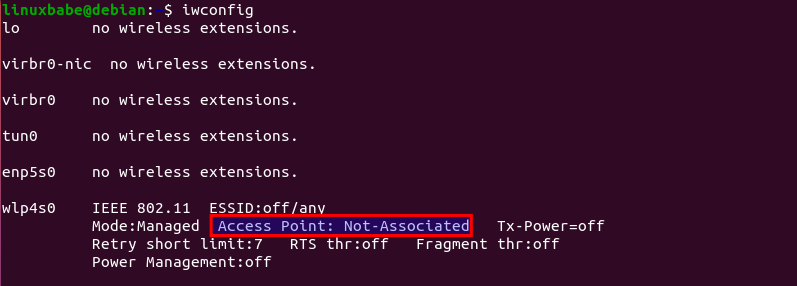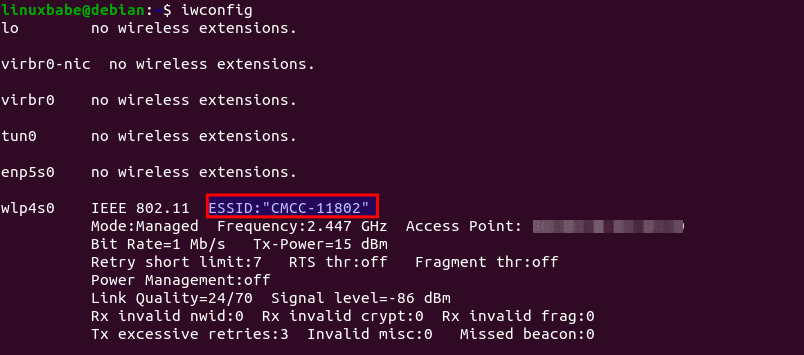- Scan for wifi Network
- Find Network Interface Card
- Release network connections
- Scan
- Setup Network Interface Card
- Acquire Network Address
- Compatible Chipsets
- Connect to Wi-Fi From Terminal on Debian 11/10 with WPA Supplicant
- Step 1: Find The Name of Your Wireless Interface And Wireless Network
- Step 2: Connect to Wi-Fi Network With WPA_Supplicant
- Connecting to Hidden Wireless Network
- Step 3: Auto-Connect At System Boot Time
- How to Obtain a Static IP Address
- Multiple Wi-Fi Networks
- Wi-Fi Security
- Wrapping Up
Scan for wifi Network
There are a multitude of fine, graphical wireless network configuration programs available to the Ubuntu community. However, there may come a day when you need to acquire a wireless connection from an unknown network on a strange network card from the recovery console. Or perhaps you just want to know how to connect to your home network from the command line. Either way, this HOWTO is for you.
This guide assumes that the drivers for your network card are properly set up. Otherwise, it would be too complicated to cover all vendors and chipsets.
Find Network Interface Card
Figure out the name of the interface for your wireless card
The interface name of cards for different vendors may be different, which is why this step is needed:
This will list the interface names for all NICs on your computer. It will probably include eth0 (hardwired NIC), lo (loopback interface for the localhost), and something for your wireless card (like wifi0, or wlan0).
For these steps let’s call whatever name you find for your wireless NIC [wifi interface].
If you have multiple wireless cards, all of them will be listed. To be sure that the interface that you select is a wireless interface, you can check that its directory contains a «wireless» folder:
cd /sys/class/net/[wifi interface]/wireless/
Release network connections
Just to be sure it’s not being used, bring your interface down, release your DHCP connection and then put it back up:
sudo ip link set dev [wifi interface] down sudo dhclient -r [wifi interface] sudo ip link set dev [wifi interface] up
Many of these commands require superuser priviledges (i.e. root access), so the sudo command precedes them. Of course, you could always use «sudo -s» or some other method to login to a shell as the root account, but why complicate matters?
Scan
sudo iwlist [wifi interface] scan
Note: In tests this command only worked with Atheros cards.
This should return results that look something like this:
wlan0 Scan completed : Cell 01 - Address: 00:04:E2:D0:D1:96 ESSID:"SMC" Mode:Master Channel:6 Frequency:2.437 GHz Quality=78/100 Signal level=-56 dBm Noise level=-127 dBm Encryption key:off Bit Rates:1 Mb/s; 2 Mb/s; 5.5 Mb/s; 11 Mb/s; 6 Mb/s 9 Mb/s; 12 Mb/s; 18 Mb/s; 24 Mb/s; 36 Mb/s 48 Mb/s; 54 Mb/s Extra:tsf=00000039cdb32ac3
The ESSID, Frequency and Address are the most important labels here (quality may also factor into your decision, too. higher is better).
Setup Network Interface Card
Set the wireless NIC so that it will connect to the found wireless network:
sudo iwconfig [wifi interface] ap [whatever you found for the MAC address] sudo iwconfig [wifi interface] essid [whatever you found for essid] sudo iwconfig [wifi interface] freq [whatever you found for frequency]G
Note the «G» after the frequency, to denote «GHz».
Acquire Network Address
Acquire a DHCP address from your wireless router:
sudo dhclient [wifi interface]
Okay. assuming that your DHCP address was acquired properly, you should have a internet connection all set up. Now, this is probably too complicated of a process to do by hand, but there are a number of ways to automate it. That’s outside the scope of this tutorial!
Compatible Chipsets
It has become apparent that not all wireless interface cards work with the scan command. Can you add your results to the table below.
Command to find the manufacture and model of your pci card is:
Connect to Wi-Fi From Terminal on Debian 11/10 with WPA Supplicant
This tutorial is going to show you how to connect to Wi-Fi network from the command line on Debian 11/10 server and desktop using wpa_supplicant, which is an implementation of the supplicant component for the WPA protocol. A supplicant in wireless LAN is client software installed on end-user’s computer that needs to be authenticated in order to join a network.
Please note that you will need to install the wpa_supplicant software before connecting to Wi-Fi, so you need to connect to Wired Ethernet first, which is done for just one time. If you don’t like this method, please don’t be mad at me. Maybe someday Debian will ship wpa_supplicant out of the box.
Step 1: Find The Name of Your Wireless Interface And Wireless Network
Run iwconfig command to find the name of your wireless interface.
wlan0 is a common name for a wireless network interface on Linux systems. On systemd-based Linux distros, you might have a wireless interface named wlp4s0 .
As you can see, the wireless interface isn’t associated with any access point right now. Then run the following command to bring up the wireless interface.
sudo ip link set dev wlp4s0 up If you encounter the following error,
RTNETLINK answers: Operation not possible due to RF-kill
you need to unblock Wi-Fi with the following command.
Next, find your wireless network name by scanning nearby networks with the command below. Replace wlp4s0 with your own wireless interface name. ESSID is the network name identifier.
sudo iwlist wlp4s0 scan | grep ESSID Step 2: Connect to Wi-Fi Network With WPA_Supplicant
Now install wpa_supplicant on Debian 11/10 from the default software repository.
sudo apt install wpasupplicant
We need to create a file named wpa_supplicant.conf using the wpa_passphrase utility. wpa_supplicant.conf is the configuration file describing all networks that the user wants the computer to connect to. Run the following command to create this file. Replace ESSID (network name) and Wi-Fi passphrase with your own.
wpa_passphrase your-ESSID your-wifi-passphrase | sudo tee -a /etc/wpa_supplicant/wpa_supplicant.conf
If your ESSID contains whitespace such as ( linuxbabe WiFi ), you need to wrap the ESSID with double-quotes ( «linuxbabe WiFi» ) in the above command.
The output of wpa_passphrase command will be piped to tee , and then written to the /etc/wpa_supplicant/wpa_supplicant.conf file. Now use the following command to connect your wireless card to the wireless access point.
sudo wpa_supplicant -c /etc/wpa_supplicant/wpa_supplicant.conf -i wlp4s0 The following output indicates your wireless card is successfully connected to an access point.
Successfully initialized wpa_supplicant wlp4s0: SME: Trying to authenticate with c5:4a:21:53:ac:eb (SSID='CMCC-11802' freq=2437 MHz) wlp4s0: Trying to associate with c5:4a:21:53:ac:eb (SSID='CMCC-11802' freq=2437 MHz) wlp4s0: Associated with c5:4a:21:53:ac:eb wlp4s0: CTRL-EVENT-SUBNET-STATUS-UPDATE status=0 wlp4s0: WPA: Key negotiation completed with c5:4a:21:53:ac:eb [PTK=CCMP GTK=CCMP] wlp4s0: CTRL-EVENT-CONNECTED - Connection to c5:4a:21:53:ac:eb completed [id=0 id_str=]
Note that if you are using Debian desktop edition, then you need to stop Network Manager with the following command, otherwise it will cause a connection problem when using wpa_supplicant.
sudo systemctl stop NetworkManager
And disable NetworkManager auto-start at boot time by executing the following command.
sudo systemctl disable NetworkManager-wait-online NetworkManager-dispatcher NetworkManager
By default, wpa_supplicant runs in the foreground. If the connection is completed, then open up another terminal window and run
You can see that the wireless interface is now associated with an access point.
You can press CTRL+C to stop the current wpa_supplicant process and run it in the background by adding the -B flag.
sudo wpa_supplicant -B -c /etc/wpa_supplicant.conf -i wlp4s0
Although we’re authenticated and connected to a wireless network, we don’t have an IP address yet. To obtain a private IP address from DHCP server, use the following command:
Now your wireless interface has a private IP address, which can be shown with:
Now you can access the Internet. To release the private IP address, run
Connecting to Hidden Wireless Network
If your wireless router doesn’t broadcast ESSID, then you need to add the following line in /etc/wpa_supplicant/wpa_supplicant.conf file.
Step 3: Auto-Connect At System Boot Time
To automatically connect to wireless network at boot time, we need to edit the wpa_supplicant.service file. It’s a good idea to copy the file from /lib/systemd/system/ directory to /etc/systemd/system/ directory, then edit the file content, because we don’t want a newer version of wpa_supplicant to override our modifications.
sudo cp /lib/systemd/system/wpa_supplicant.service /etc/systemd/system/wpa_supplicant.service
Edit the file with a command-line text editor, such as Nano.
sudo nano /etc/systemd/system/wpa_supplicant.service
ExecStart=/sbin/wpa_supplicant -u -s -O /run/wpa_supplicant
Change it to the following. Here we added the configuration file and the wireless interface name to the ExecStart command.
ExecStart=/sbin/wpa_supplicant -u -s -c /etc/wpa_supplicant/wpa_supplicant.conf -i wlp4s0 It’s recommended to always try to restart wpa_supplicant when failure is detected. Add the following right below the ExecStart line.
Save and close the file. (To save a file in Nano text editor, press Ctrl+O , then press Enter to confirm. To exit, press Ctrl+X .) Then reload systemd.
sudo systemctl daemon-reload
Enable wpa_supplicant service to start at boot time.
sudo systemctl enable wpa_supplicant.service
We also need to start dhclient at boot time to obtain a private IP address from DHCP server. This can be achieved by creating a systemd service unit for dhclient .
sudo nano /etc/systemd/system/dhclient.service
Put the following text into the file.
[Unit] Description= DHCP Client Before=network.target After=wpa_supplicant.service [Service] Type=forking ExecStart=/sbin/dhclient wlp4s0 -v ExecStop=/sbin/dhclient wlp4s0 -r Restart=always [Install] WantedBy=multi-user.target
Save and close the file. Then enable this service.
sudo systemctl enable dhclient.service
How to Obtain a Static IP Address
If you want to obtain a static IP address, then you need to disable dhclient.service .
sudo systemctl disable dhclient.service
Create a network config file.
sudo nano /etc/systemd/network/static.network
[Match] Name=wlp4s0 [Network] Address=192.168.1.8/24 Gateway=192.168.1.1
Save and close the file. Then create a .link file for the wireless interface.
sudo nano /etc/systemd/network/10-wifi.link
Add the following lines in this file. You need to use your own MAC address and wireless interface name. This is to prevent the system from changing the wireless interface name.
[Match] MACAddress=a8:4b:05:2b:e8:54 [Link] NamePolicy= Name=wlp4s0
Save and close the file. Then disable the networking.service and enable systemd-networkd.service , which will take care of networking.
sudo systemctl disable networking sudo systemctl enable systemd-networkd
You can now restart systemd-networkd to see if your configuration works.
sudo systemctl restart systemd-networkd
Another way to obtain a static IP address is by logging into your router’s management interface and assigning a static IP to the MAC address of your wireless card, if your router supports this feature.
Recommended Reading:
Multiple Wi-Fi Networks
The /etc/wpa_supplicant.conf configuration file can include multiple Wi-Fi networks. wpa_supplicant automatically selects the best network based on the order of network blocks in the configuration file, network security level, and signal strength.
To add a second Wi-Fi network, run:
wpa_passphrase your-ESSID your-wifi-passphrase | sudo tee -a /etc/wpa_supplicant/wpa_supplicant.conf Note that you need to use the -a option with the tee command, which will append, instead of deleting the original content, the new Wifi-network to the file.
Wi-Fi Security
Do not use WPA2 TKIP or WPA2 TKIP+AES as the encryption method in your Wi-Fi router. TKIP is not considered secure anymore. You can use WPA2-AES as the encryption method.
Wrapping Up
I hope this tutorial helped you connect Debian 11/10 to Wi-Fi network from the command line with WPA Supplicant. As always, if you found this post useful, then subscribe to our free newsletter to get more tips and tricks 🙂




